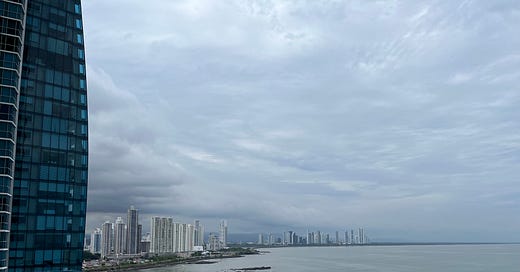Panama City, Panama
April 26, 2024
Much of the world is an incorrigible mess. But Latin America (of all places) offers glimmers of hope.
A few months ago in the southern cone, the Argentines…finally fed up tangoing with crony socialism and inflationary fascists…ditched the Peronists, and elected an avowed libertarian as president.
After his inauguration, Javier Milei waited about a day before taking his chainsaw to bungling bureaucracies and prodigal departments. Within a few months, half were gone, and peso prices began to recede.
This week we learned the Argentine budget boasted its first quarterly surplus in sixteen years. There’s much more to do…and Milei’s international instincts seem to be a mess…but things seem promising on the Pampas.
To the north is one of the few countries grateful for Haiti, if only because it made El Salvador look like less of a hellhole. But five years ago, a new president came to power.
Declaring bitcoin Salvadoran legal tender, Nayib Bukele brought commitments to sound money and public safety to a country afflicted with the most per capita murders in the western hemisphere.
Not any more. His Territorial Control Plan cracked down on endemic gang violence, cutting El Salvador’s homicide rate in half after one year and by a factor of twenty since Bukele took office.
Situated between these incipient success stories, Panama can’t brag about such abrupt improvements. But it can be proud of continual ones.
It can boast of being a country that’s never suffered a central bank. It’s also (coincidentally?) the only one in Latin America that hasn’t endured a financial collapse or currency crisis.
Prior to independence, Panama was under Colombian control. Heavily reliant on transit and trade, it used currency based on silver and gold. It resisted imposition of fiat paper. As its main newspaper put it in 1886:
“there is no country on the globe, certainly no commercial center, in which the disastrous consequences of the introduction of an irredeemable currency would be felt as in Panama. Everything we consume here is imported. We have no products and can only send money in exchange for what is imported.”
Upon independence in 1903, Panama’s constitution prohibited fiat currency:
“There will be no forced fiat paper currency in the Republic. Thus, any individual can reject any note that he may deem untrustworthy.”
Of course, the U.S. Constitution includes a similar prohibition, which is honored as diligently as the rest of that document.
The Panamanian Balboa (named for the Spanish explorer, not the Italian Stallion) and U.S. Dollar each circulate as legal tender. As everywhere else, the gold backing is long gone.
But Panama has among the most liberal banking laws in the world. These derive from Omar Torrijo’s financial reorganization in 1970, for which he was compensated with massive influxes of foreign loans.
Seven years later, the Panama Canal Treaty also accelerated cash coming thru the country. The debate over that agreement is among my earliest political memories.
As with Watergate a few years earlier and the Iran hostage crisis a couple years later, I didn’t know the details.
But it dominated the news, so I knew was a big deal. As a kid, I remember thinking it seemed stupid to give up the canal.
I recall being a nine year-old, arguing with my family that the Torrijos regime couldn’t be trusted, and how it was despicable that international conglomerates and Deep State bankers convinced Jimmy Carter to forfeit a crown jewel to a corrupt Communist.
Just kidding.
I had no idea what was going on. I just thought the canal sounded cool. When I was told America owned it, I wondered why it would let others have it…even those thru whose country it was carved. After all, as Senator S.I. Hayakawa said during the Treaty debates, “we stole it fair and square.”
My enthusiasm for the canal was sincere, perhaps a portent of an emerging affinity for engineering. To the detriment of my childhood lawn, I even acted on it. My mother will attest that my exuberance led me to dig dozens of “canals” behind our house, destroying what had been our backyard.
I was correct that the Panama Canal was cool. But I was childishly naive thinking the U.S. government ever intended to really give it up.
The 1977 treaty that ostensibly yielded the canal to Panama included provisions for maintaining US military bases and perpetual rights of American intervention. As with modern elections, it allowed imperial dominance to persist while leaving locals an illusion they were in control.
But many Panamanians didn’t buy the ruse. Thousands protested the “dirty treaty”, suspecting the Torrijos regime was accepting genuine bribes for fake sovereignty.
Under terms of the treaty, US payments to Panama to compensate things like canal tonnage, dockage, and ship repair would rise thirty-fold.
The first few years included hundreds of millions (real money at the time) in corporate boondoggles masked as loan guarantees and credits, filtered thru such funnels as the Export-Import Bank, Agency for International Development, and Overseas Private Investment Corporation.
As with all larceny disguised as “foreign aid”, taxpayer money would be laundered by the U.S. government thru foreign recipients to favored exporters. The treaty contained “Buy America” provisions to expedite these financial flows to desired destinations.
As always, among the biggest beneficiaries were US banks, to which the Panamanian government was deeply in debt. As part of the “anti-imperialist” treaty, US taxpayer dollars helped subsidize Panama’s interest and principal payments, providing a covert bailout to Wall Street stalwarts.
This isn’t unusual, and shouldn’t be shocking. More often than not, to find reasons we must follow the money. As I write, I’m on a bus to see part of what it bought.
Tomorrow we’ll take a closer look.
JD




